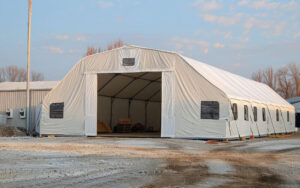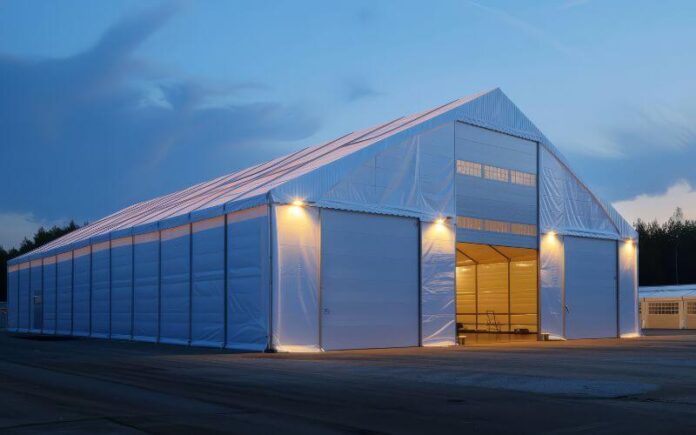Fabric buildings offer a dynamic and sustainable solution for businesses seeking flexible, cost-effective, and environmentally friendly workspaces. These innovative structures can be tailored to a wide range of applications, from warehousing and manufacturing to retail and events.
This guide will explore the numerous advantages of fabric buildings, including their rapid deployment, durability, and energy efficiency.
What Are Fabric Buildings?
Fabric buildings use a durable fabric membrane stretched over a robust framework, typically made of steel or aluminum. These large fabric structures offer a versatile and cost-effective alternative to traditional construction, providing functional spaces for various applications. Their innovative design, characterized by a lightweight yet durable construction, makes them popular in agriculture, manufacturing, warehousing, sports, and events.

Benefits of Fabric Buildings in Businesses
Fabric buildings provide a practical solution for companies looking to maximize space, reduce expenses, and maintain flexibility in their operations. Here are the numerous benefits fabric buildings bring to businesses across industries:
1. Cost-Effective Construction
One of the most significant advantages of fabric buildings is their affordability compared to traditional construction methods. The materials used in fabric structures, such as high-strength fabrics and metal frames, are generally less expensive than those used in brick-and-mortar buildings.
Furthermore, the streamlined construction process reduces labor costs and time, as these buildings can often be assembled in weeks instead of months. This rapid deployment helps businesses minimize downtime and allows for quicker space utilization.
2. Flexibility and Customization
Fabric buildings are exceptionally adaptable, offering a range of design options to suit different business needs. These structures can be built in various sizes and configurations, from small storage units to expansive warehouses or sports facilities. Customization extends to features such as doors, ventilation, insulation, and lighting systems, enabling businesses to tailor the building to their requirements.
Their modular design allows for future expansions, meaning your structure can grow with your business. Moreover, fabric buildings can be easily relocated, making them a dynamic solution for companies with evolving operational demands or temporary needs.
3. Durability and Longevity
Modern fabric structures are built with durability in mind, using advanced materials like polyethylene or PVC-coated fabrics supported by steel or aluminum frameworks. These materials are engineered to endure extreme weather conditions, such as heavy snow, high winds, and intense sunlight, ensuring reliability in various climates.
Unlike older iterations, contemporary tension fabric buildings are designed to resist wear and tear, with UV-resistant and waterproof coatings that prolong their lifespan. With proper care and maintenance, these structures can last for decades, making them a valuable long-term investment for businesses seeking durable and dependable infrastructure.
4. Natural Lighting and Energy Efficiency
One of the unique features of fabric buildings is their ability to harness natural light. Many fabric structures use translucent materials that allow sunlight to filter through, significantly reducing the need for artificial lighting during the day. This lowers energy costs and creates a brighter, more pleasant environment for employees and operations.
Additionally, fabric buildings can be equipped with insulation systems that help maintain stable indoor temperatures, reducing the need for heating or cooling. This energy efficiency benefits businesses by cutting utility expenses while contributing to environmentally sustainable operations.
5. Eco-Friendly Construction
Fabric buildings are an environmentally conscious choice, especially for businesses that prioritize sustainability. The materials used in these structures are often recyclable, reducing waste during construction and eventual decommissioning.
Unlike traditional construction methods, which typically involve extensive material consumption and energy use, fabric buildings have a lower carbon footprint due to their efficient design and assembly process. Furthermore, their energy efficient features, such as natural lighting and insulation, align with green initiatives, making them an excellent option for companies seeking eco-friendly solutions.
6. Quick Installation and Portability
Speed and mobility are critical factors for many businesses, and fabric buildings excel in both areas. These structures can be installed quickly, often within days or weeks, making them ideal for immediate space solutions, such as disaster relief or seasonal operations.
Their lightweight components and modular designs also allow them to be easily disassembled and relocated, providing businesses with the flexibility to adapt to changing circumstances. Whether you need temporary storage on a remote site or a portable shelter for events, fabric buildings deliver unmatched convenience and adaptability.
7. Low Maintenance Requirements
Another notable benefit of fabric buildings is their minimal maintenance requirements. Unlike traditional buildings that may require frequent repairs due to rust, rot, or pest damage, fabric structures are constructed from materials designed to resist these issues.
The metal frames are often galvanized to prevent corrosion, while the fabric components are treated to repel moisture and pests. Routine upkeep typically involves periodic, cost-effective, and straightforward inspections and cleaning. This reduced maintenance translates into significant savings over time and ensures that your building remains in excellent condition for years.
By leveraging the numerous benefits of fabric buildings, businesses can enhance efficiency, reduce costs, and adopt a flexible infrastructure tailored to evolving demands.
Conclusion
As you’ve seen, fabric buildings offer a compelling blend of flexibility, durability, and cost-effectiveness. Whether expanding your operations, seeking a temporary solution, or aiming to reduce your environmental footprint, fabric buildings provide a practical and sustainable choice.
